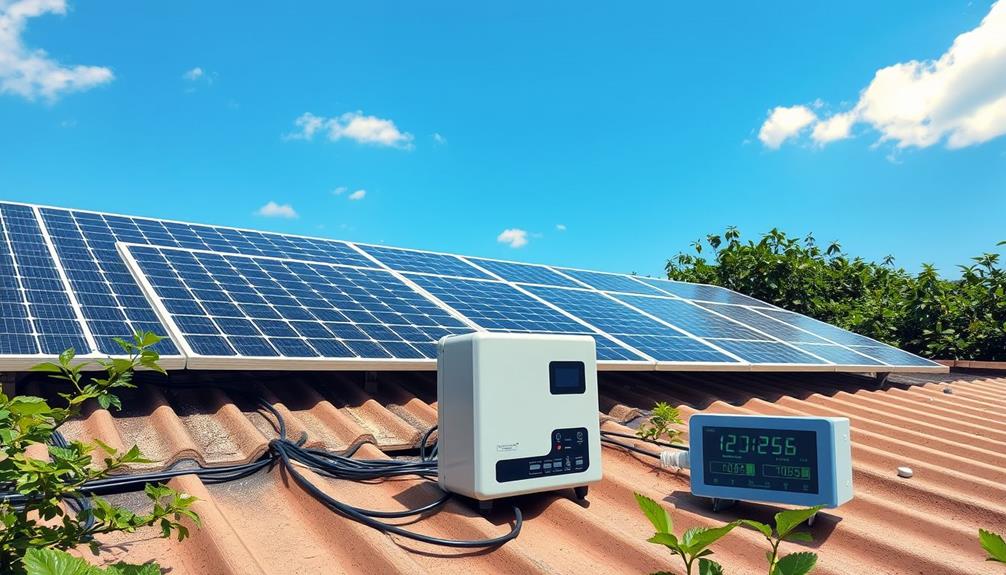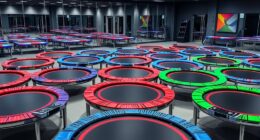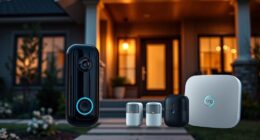You can cut your energy bills in half by exploring wind generators. These systems convert wind energy into electricity, potentially reducing your costs by up to 100%, depending on where you live and local wind conditions. Understanding turbine functionality and selecting the right size for your needs is essential. Plus, maneuvering zoning regulations and taking advantage of financial incentives can enhance your savings. By efficiently harnessing wind power, you're not just saving money; you're also contributing to a greener planet. Curious about how to maximize your setup? You'll discover tactics that can elevate your energy efficiency even further!
Key Takeaways
- Wind energy can reduce electricity bills significantly, with potential savings of up to 100% based on location and wind resources.
- Small wind projects typically cost around $5,120 per installed kilowatt, with incentives available to offset initial investments.
- Ideal sites for wind turbines should have average wind speeds of 10 mph or more to maximize energy generation.
- Engaging in energy efficiency practices, such as sealing air leaks and upgrading appliances, can complement wind energy savings.
- Compliance with local zoning regulations and utility interconnection requirements is essential for successful wind turbine installation.
Why Choose Wind Energy?

When it comes to cutting your energy bills, wind energy stands out as a smart choice. By investing in a small wind electric system, you could potentially slash your electricity costs by up to 100%, depending on your location and wind resources.
If you live in a rural area—around 19.3% of the U.S. population does—you're in a prime spot to harness this renewable energy, making it an ideal solution for many homeowners. Additionally, much like diversifying a retirement portfolio with options such as a Gold IRA for financial protection, integrating wind energy into your home can safeguard against fluctuating energy prices and enhance your financial resilience.
Wind energy isn't only cost-effective but also environmentally friendly, contributing to national sustainability goals. By switching to wind, you enhance your energy efficiency and reduce your carbon footprint while enjoying the benefits of a clean power source.
Investing in wind energy can be particularly advantageous for those in remote locations, as it can help you avoid high utility line extension costs.
The average cost of small wind projects was around $5,120 per kilowatt in 2021, which makes it an economically feasible option for lowering long-term energy expenses.
Understanding Wind Turbine Functionality

To understand how wind turbines work, you need to look at their key components and the energy conversion process.
The rotor blades, which can weigh anywhere from 280 grams to 26 tons, capture wind energy and spin a generator to produce electricity, turning kinetic energy into usable power.
Larger blades are designed to capture more wind energy, enhancing overall efficiency and output, particularly at ideal wind speeds significant energy generation.
Components of Wind Turbines
Understanding the functionality of wind turbines lies in recognizing their fundamental components. These machines primarily consist of a rotor, which captures wind energy, a generator that converts the rotational energy into electricity, and a tower that elevates the rotor to harness higher wind speeds.
Horizontal-axis turbines are the most common, with rotor blades positioned at least 30 feet above obstacles to optimize wind capture and energy production. Additionally, selecting the best heat pump can complement your wind energy system, as it enhances your overall energy efficiency and comfort in different weather conditions optimal comfort in varying weather conditions.
The balance of system components, including wiring and auxiliary parts, is vital for the overall functionality of your energy systems. To evaluate your investment in wind energy, understanding these components is key. Factors like wind availability and system design greatly influence turbine efficiency, which directly impacts energy consumption and performance metrics.
Installation costs for small wind projects average around $5,120 per kilowatt, influenced by local zoning, permitting, and utility interconnection requirements.
Energy Conversion Process
Wind turbines play an essential role in converting wind energy into usable electricity, and this process begins with the rotor blades. These blades capture the kinetic energy from the wind and transform it into mechanical energy as they rotate.
The rotor, typically consisting of two to three blades, is designed to enhance energy capture, especially at higher wind speeds, making your energy production more efficient. Understanding the common financial terms associated with energy investments can also help you make informed decisions regarding the financial implications of installing a wind generator.
Horizontal-axis wind turbines are the most common type, with their blades positioned horizontally to face into the wind. This orientation maximizes energy capture and enhances overall performance.
To guarantee ideal wind exposure, it's vital that the rotor blades are at least 30 feet above nearby obstacles.
Enhancing Home Energy Efficiency

Enhancing home energy efficiency is essential for reducing your energy bills and creating a more sustainable living environment. By focusing on key areas, you can greatly lower your home energy consumption and expenses. Here are some effective strategies to take into account:
- Seal air leaks: Addressing gaps around windows and doors can reduce heating and cooling costs by 10% to 20%.
- Upgrade to ENERGY STAR appliances: These energy-efficient models use less energy, saving you between 10% and 50% on your bills. With options like innovative technology in appliances, you can further enhance efficiency in your home.
- Perform regular HVAC maintenance: Changing air filters and scheduling annual tune-ups can improve system efficiency and cut costs by up to 20%.
- Utilize smart technology: Smart thermostats and programmable appliances help manage energy use, potentially saving an average of 8% on heating and cooling expenses.
Additionally, think about conducting a professional energy audit. It can reveal hidden inefficiencies in your home, leading to targeted improvements that yield substantial energy savings.
Assessing Zoning and Permitting

When evaluating the installation of wind generators, it's crucial to navigate the local zoning and permitting landscape effectively. Start by checking the zoning regulations in your area to see if wind energy installations are permitted. Each jurisdiction has its own rules, which can greatly impact your project.
Additionally, it's important to examine the benefits of sustainable practices, such as eco-friendly options that promote energy efficiency and conservation.
Permitting is another key step. You'll need to obtain specific approvals from local authorities, often addressing concerns about safety, aesthetics, and environmental impact. Understanding these processes can streamline your installation and potentially lower costs.
Be prepared for common zoning challenges, such as height restrictions on wind turbines, usually capped at around 35 feet. Additionally, you may encounter objections from neighbors regarding noise and visual impact, so it's wise to engage with your community early on.
To aid in the permitting process, explore resources like the Clean Energy States Alliance, which offers toolkits designed to help local governments navigate zoning and permitting issues effectively.
Determining Turbine Size Requirements

After traversing the zoning and permitting landscape, the next step is determining the appropriate size of your wind turbine. The required turbine size primarily hinges on your energy needs, as a general rule of thumb suggests that 1 kilowatt (kW) of turbine capacity can yield around 1,500 to 2,000 kilowatt-hours (kWh) annually in ideal wind conditions.
Additionally, understanding how to enhance your energy consumption can aid in selecting the right turbine size, as can exploring mastering the art of bug out bags for essential preparedness strategies.
To make an informed decision, consider the following factors:
- Annual energy consumption: Calculate your household or business's total energy needs.
- Average wind speed: A site with an average wind speed of 10 mph or more is ideal for small wind systems.
- Local zoning regulations: Be aware of height restrictions or other limitations that might affect turbine size.
- Rotor diameter: Opt for larger rotors, as they capture more wind energy; verify blades are at least 30 feet above nearby obstacles.
Key Components of Wind Systems

At the heart of every wind energy system lies a few key components that work together to harness the power of the wind. The primary components include the rotor, which captures wind energy and converts it into rotary motion; a generator or alternator, which transforms this motion into electricity; and a tower, elevating the rotor to access stronger winds. The wind turbine rotor blades are essential in capturing the kinetic energy of the wind and transferring it to the rotor. These blades have been designed to be aerodynamically efficient, enabling them to turn at the slightest breeze. Additionally, the tower’s height is crucial in accessing higher and more consistent wind speeds, allowing for maximum energy production.
Here's a quick overview of these key components:
| Component | Description |
|---|---|
| Rotor | Captures wind energy and converts it into motion |
| Generator | Converts rotary motion into electricity |
| Tower | Elevates the rotor for ideal wind exposure |
| Balance of System | Includes wiring, controls, and other essential parts |
For ideal performance, verify the rotor blades are at least 30 feet above nearby obstacles. While horizontal-axis turbines dominate the market due to their efficiency, vertical-axis turbines are also available. As you plan for your wind energy system, don't forget about installation costs, which can include local zoning and permitting expenses. Understanding these key components will help you make informed decisions and effectively cut your electricity costs.
Cost Analysis of Wind Energy

When considering wind energy, you'll need to weigh the initial investment costs against the long-term savings potential.
While installing a small wind system can be pricey upfront, many homeowners see significant reductions in their electricity bills over time.
Exploring options like Gold IRAs for retirement planning can also offer financial stability as you invest in sustainable energy solutions.
Evaluating your local wind conditions and available incentives can help you determine if this investment makes sense for you.
Initial Investment Costs
Investing in wind energy can be a significant financial commitment, with the average cost of small wind projects around $5,120 per installed kilowatt as of 2021.
Before diving into wind energy systems, it's vital to take into account the initial investment costs, which can vary widely. Factors such as local zoning, permitting, and utility interconnection expenses can all influence your overall financial commitment.
Additionally, understanding the impact of your energy consumption patterns on your budget can help you make more informed decisions about renewable energy solutions like wind power. Incorporating effective strategies for weight loss may also encourage a more sustainable lifestyle that complements your energy-saving efforts.
Here are some key points to keep in mind:
- Installation costs can differ based on location and project specifics.
- Incentives and rebates may be available to help offset your initial costs.
- Economic feasibility is higher in areas with elevated energy bills or limited utility access.
- Understanding total costs, including components and labor, is essential for effective budgeting.
Long-term Savings Potential
The long-term savings potential of wind energy can be substantial, especially for homeowners looking to cut their electricity bills. With the average cost of small wind projects around $5,120 per kilowatt in 2021, investing in a wind energy system could be a wise financial decision, particularly in areas with consistent wind availability.
Additionally, households can also explore innovative solutions for reducing utility costs, such as toilet flushing mechanisms that promote water efficiency. You could potentially reduce your energy bills by up to 100%, making your investment pay off quickly.
Moreover, if you face high electricity bills or have limited access to utility services, wind systems can bring significant savings over time. The economic feasibility of these systems is enhanced by incentives and tax credits, such as those from the Inflation Reduction Act, which can cover up to 30% of installation costs. This support makes wind energy even more accessible and cost-effective.
To maximize your long-term savings, consider conducting on-site wind assessments. Accurate data on local wind patterns will help you better estimate your annual energy output and savings.
Energy Generation Potential

Harnessing the power of wind can lead to substantial savings on your energy bill, especially if you live in an area with favorable wind conditions. Understanding your energy generation potential is fundamental for maximizing the benefits of wind electric systems. Factors like local wind resources and average wind speeds play significant roles in determining how much energy you can generate.
To guarantee you're making the most of your investment, consider these key points:
- Location Matters: High average wind speeds are typically found near seacoasts, ridgelines, and the Great Plains.
- Data Collection: On-site wind data is more reliable than state wind maps for evaluating your energy generation potential.
- Rotor Size: The size of the rotor directly impacts energy output; optimizing it according to local conditions is critical.
- Cost Evaluation: The average cost of small wind projects can be significant, so analyzing installation costs against local wind resources is essential.
Connecting to the Utility Grid

Connecting your wind generator to the utility grid can be a game changer for your energy bills. By tapping into net metering, you can feed excess energy back into the grid, helping offset your energy costs and potentially leading to considerable savings on your utility bills.
However, proper grid interconnection requires compliance with local utility regulations. You'll need to adhere to specific technical requirements and safety measures to guarantee seamless energy transfer. Typically, this involves installing an inverter to convert the generated DC power into AC power, making it compatible with the grid's electricity supply.
Before you get started, consult your local utility providers for information on interconnection agreements. These agreements outline the terms and conditions for connecting your renewable energy systems to the grid, ensuring you know what to expect.
Additionally, don't overlook the financial incentives and rebates that might be available for grid-tied wind systems. These can enhance your project's economic viability and greatly reduce the upfront costs associated with installation.
Frequently Asked Questions
Do Wind Turbines Lower Electric Bills?
Yes, wind turbines can lower your electric bills considerably. By generating your own electricity, you'll reduce reliance on the grid, potentially saving you money and even offsetting rising energy costs over time.
How to Cut Electricity in Half?
Cutting your electricity bill in half might seem challenging, but it's achievable. You can start by upgrading to ENERGY STAR appliances, sealing leaks, or using smart technology. Every small change adds up to significant savings!
How Long Does It Take for a Wind Generator to Pay for Itself?
It usually takes 6 to 30 years for a wind generator to pay for itself, depending on installation costs and local wind conditions. Optimizing your home's energy efficiency can help reduce this payback time considerably.
What Size Wind Turbine Is Needed to Power a House?
To power your house, you typically need a 5 to 15 kW wind turbine. A 10 kW model works well under suitable wind conditions, but check your local wind resources and regulations first.
Conclusion
In the end, choosing wind energy is like planting a seed for a sustainable future. By harnessing the power of the wind, you can notably cut your energy bills while contributing to a cleaner environment. With the right turbine and proper planning, you'll not only boost your home's energy efficiency but also enjoy the freedom from rising utility costs. So, why wait? Embrace wind energy and watch your savings soar like a kite in the breeze!










